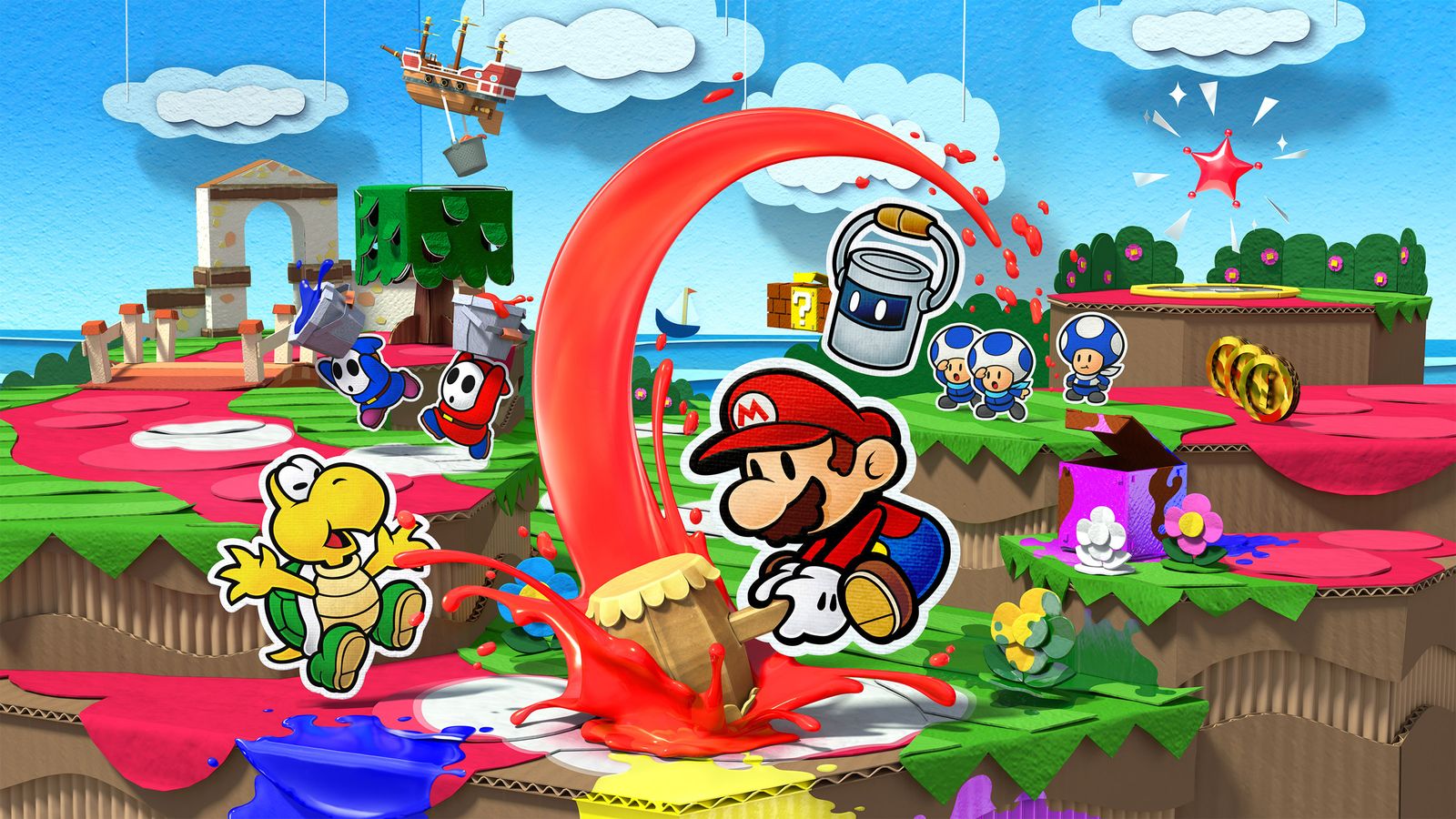Paper Mario: Sticker Star easily stands as one of the most contested entries in an otherwise beloved subseries of Mario RPG’s. Despite the controversy though, this wasn’t enough to deter Nintendo from taking a mulligan on the fundamental ideas behind Paper Mario: Sticker Star, this time on Wii U, rather than Nintendo 3DS. This led to the series’ latest entry, Paper Mario: Color Splash, which also sports the dubious distinction of being the last Wii U-exclusive game release from Nintendo, since the imminently-releasing The Legend of Zelda: Breath of the Wild is also launching on Nintendo’s highly anticipated Nintendo Switch hybrid platform, on top of its initially planned Wii U release.
Paper Mario: Color Splash is a bit of a bizarre note to end the Wii U’s first-party exclusive roster on, since it’s expanding upon a game that plenty of longtime Paper Mario fans disliked. For what it’s worth though, Paper Mario: Color Splash is an improvement over Paper Mario: Sticker Star, even if it’s also still falling noticeably beneath the standard of the especially-beloved initial two entries in the Paper Mario series, Paper Mario for Nintendo 64 and Paper Mario: The Thousand-Year Door for GameCube.
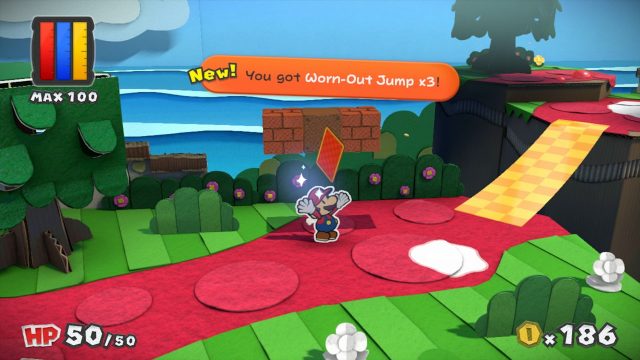
This game is thus hardly an excuse to chase down Nintendo’s infamously failed Wii U console, if you don’t already own it, though it makes for at least a decent adventure to send the console out on if you do own a Wii U, and aren’t planning to enjoy The Legend of Zelda: Breath of the Wild on it. The simplified gameplay remains more casual-flavoured than the Paper Mario series’ fan-favourite origins however, with some Paper Mario: Sticker Star complaints sadly remaining in Paper Mario: Color Splash, despite the improvements to the formula. As long as you don’t mind the lightweight progression though, Paper Mario: Color Splash is pretty entertaining, and, appropriately, offers a pretty colourful adventure that is lengthy enough to satisfy.
The striking art style of Paper Mario has always been an enjoyable showcase of any given Nintendo platform’s artistic capabilities, and this latest title in the series is no exception. The series’ high-definition debut leads to the most crisp and richly-developed papercraft environments in the series to date, with extra vibrant colours and extra detailed animations coming from every character and battle effect. Paper Mario: Color Splash pops with a ton of playful style both in and out of battles, and is easily one of the most visually polished Paper Mario games to date!
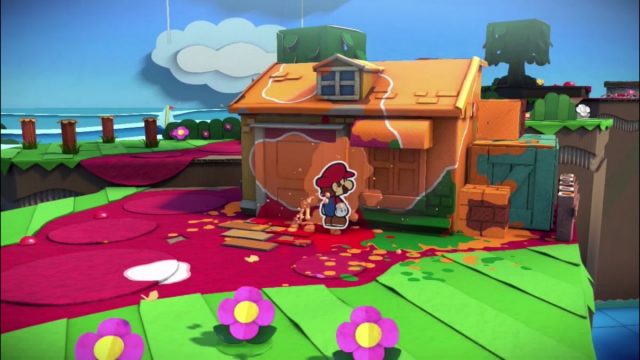
The use of colour as a key story and gameplay hook also leads to an especially visually stimulating experience in Paper Mario: Color Splash. Watching Mario and his enemies gradually lose colour rather than HP as they’re damaged, just as Mario’s Paint Hammer covers the land in vivid, lively hues that revitalize the drained monochrome, always looks great, and gives this game a lot of personality. The contrasting of more realistic ‘Things’ that are done in a more CG-rendered style still work surprisingly well with the papercraft 2D/3D hybrid presentation of Paper Mario as well, with the Thing animations and effects looking all the better now that they’re realized on a high-definition console, rather than a handheld. Pair this with consistently reliable, uninterrupted game performance, and you have a pretty visually upbeat, eye-popping graphical swan song for the Wii U.
There is a lot of energy behind the music suite of Paper Mario: Color Splash, which is just as catchy and lovable as you would come to expect from a Paper Mario game. The jazzy battle theme, peppy environmental tunes and no shortage of comical cutscene compositions all come together to make a particularly strong Paper Mario soundtrack here. You’ll easily be able to hum and bop along to the game’s many battle themes and stage themes, which do a great job of keeping you in high spirits throughout Mario’s latest papercraft quest.
The rest of the audio work also appears to be especially exaggerated and jazzy, with Mario seemingly contributing to the chipper music with every stomp and hammer whack upon enemies within battle. Outside of battle, satisfying paint splashes and paper cutting lead to an environment that feels malleable, and yet also alive in its own cartoon-ish fashion. There’s a sense of humourous scale to the diorama-like environments of Paper Mario: Color Splash, which sometimes rise up directly against the player, creating obstacles as humourous as they are deadly. The audio always stays on point too, making you laugh, even as you’re running and fighting for your life!
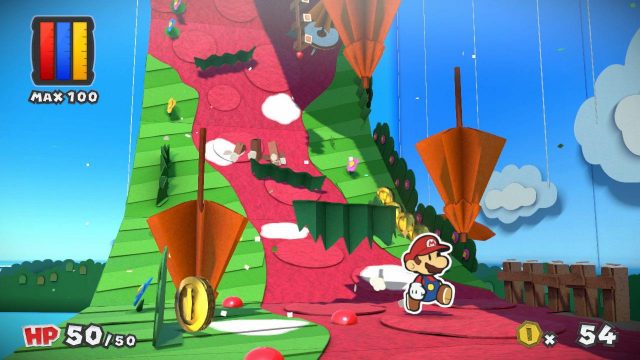
As usual for any Paper Mario game however, it’s still a bit of a disappointment that dialogue is entirely conveyed through text, with pretty much no voice acting whatsoever in Paper Mario: Color Splash. Mario will occasionally make some musings and exclamations, ironically being the one character who never directly speaks amid a cast of other characters that only speak in text bubbles, but it’s nonetheless a let-down that this series is still shirking voice acting, even in the twilight of the Wii U era. There’s still plenty of personality to go around, even in text, though the game’s lively charm still feels like it could go further with characters that more actively emote and properly speak.
Paper Mario: Color Splash, in following the example of Paper Mario: Sticker Star before it, still only offers diminished RPG elements in contrast to the series’ original two games. This will probably disappoint more serious RPG gamers, even if it’s also clear that Paper Mario: Color Splash is a more simple, light-hearted adventure that isn’t meant to hold the attention of those seeking an experience on the level of Final Fantasy XV or Fallout 4.
Paper Mario: Color Splash still boasts a turn-based combat system nonetheless, despite the reduced RPG element emphasis, with the system of arranging and using a deck of ‘Battle Cards’, rather than simple menu commands, returning here from Paper Mario: Sticker Star. If you’re unfamiliar with this system, it’s very easy to grasp. If you want Mario to jump on an enemy for example, you play a consumable ‘Jump’ card during your turn, just as you play a ‘Hammer’ card whenever you want him to swing his hammer instead. If Mario needs to heal, you play a ‘Mushroom’ card, and if he needs to use support items to help attack enemies, you might play a card like ‘Fire Flower’ or ‘Ice Flower’. It’s a very simple system, with Mario being able to play and carry more Battle Cards as the game goes on, giving you more means to take on more complex foes with a greater set of attack and item options. Paper Mario: Color Splash also adding in the new ability to paint colourless Battle Cards, making them more powerful and effective so long as you have paint to spare for it, also contributes some nice heightened depth to the combat over the previous Paper Mario: Sticker Star.
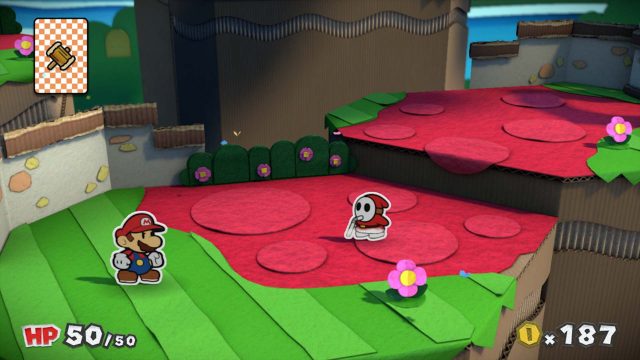
With EXP and party members completely absent in this game though (beyond some Battle Cards that can temporarily summon enemies to fight with you), you could also just as easily consider Paper Mario: Color Splash an action-adventure game, one that simply has a very RPG-esque combat system. As with any Mario RPG too, you can also enhance your attacks in combat by carefully timing button presses in time with Mario’s actions, which can make your strikes more or less effective, depending on your timing. The same is true when enemies attack Mario, with other carefully-timed button presses allowing you to avoid some potential damage by having Mario defend at the proper moment. This hybrid of turn-based and action-based combat has always defined the Mario RPG’s very well, so it’s unsurprising to see these mechanics return in Paper Mario: Color Splash, reliable as ever.
As much as a pessimist could think of Paper Mario: Color Splash as an entry-level RPG made mainly for genre rookies though, especially since there’s no EXP earned in combat, nor stats to manage for Mario, there’s enough depth and surprises in combat to avoid the feeling that the game is a complete cakewalk, even if the adventure’s first half at least will still often be rather easy for more avid gamers. You’ll get liberal hints about how to gain an edge against the especially devious bosses in the game, if you talk to other characters frequently and pay attention to clues, but even then, there’s enough of a loose leash given to players to nonetheless encourage them to be creative and experiment. This is especially evident with the Things, as some unexpected Things can be the key to making progress in especially tricky battles, especially in key boss fights for the game’s all-important macguffins, the six lost Paint Stars.
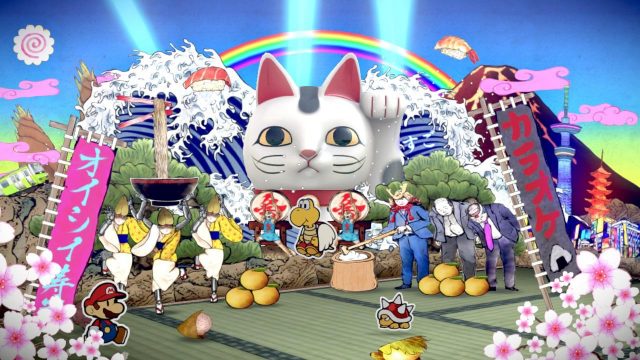
Outside of battle, you’ll find another fairly typical Paper Mario game, one that has Mario navigating papercraft-esque environments, using jumps, his hammer and other such mechanics to bypass obstacles, trigger combat with enemies in the field, and solve puzzles. The main objective of each stage is to reach a Mini Paint Star at the end (some stages also offer multiple Mini Paint Stars that can open several different paths on the overworld menu), blending a loose inspiration from the mainline Mario platformers with the adventure/RPG hybrid sensibilities unique to Paper Mario. The fundamental environmental progression here should be very familiar to Paper Mario veterans, though some new mechanics do mix up the exploration in contrast to former titles. Chief among these is Mario’s Paint Hammer, which, as previously mentioned, is used to fill in colourless spots in the field, which can rejuvenate environments and characters for a variety of rewards. Restoring colour to certain characters will often net you valuable tips and means to proceed further, for example. Likewise, while restoring environments often just nets you more coins and Battle Cards, it can also sometimes be a necessary part of opening paths forward.
This need to be thorough with re-painting the game’s setting of Prism Island will encourage players to whack as much scenery with the regular hammer as they can, to amass red, blue and yellow paint to store in the Paint Hammer, which is used to colour environments. Obviously, secondary colours like orange, green and purple drain multiple meters of paint, which is your best encouragement to battle enemies and win, so you can increase the amount of paint that the Paint Hammer can hold. Fortunately, you’re not obligated to use paint at all times though, since you use the X Button whenever you want to wield the Paint Hammer, and can just use the regular hammer with the B Button.
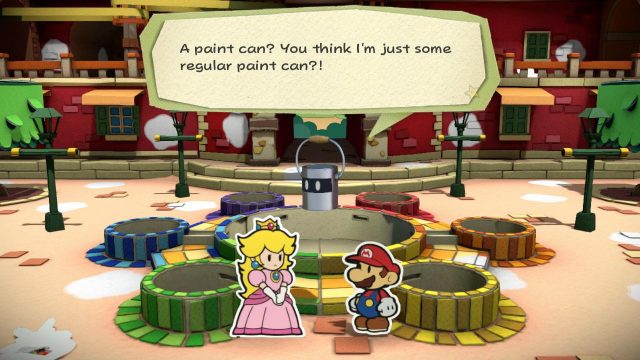
Another key mechanic for navigating certain obstacles in Paper Mario: Color Splash comes from the Dimensional Shift ability, which can be triggered in certain spots in the field using the Y Button. This mechanic is the key reason why the default Wii U Gamepad is the only control method supported by Paper Mario: Color Splash, since you use the stylus on the Wii U Gamepad Screen during these moments to ‘cut out’ pieces of the environment, opening up physically impossible new paths for Mario that can allow him to bypass seemingly impassable barriers. If you’re truly stuck, and have no perceivable way forward, dimensional manipulation might be exactly what you need to do to proceed ahead. It’s a weird mechanic, but then, this is a weird series of games, so the shoe fits.
These are all functional mechanics both in and out of battle, with other gameplay hooks also providing some solid entertainment, though I would be spoiling key parts of the story, humour and gameplay surprises if I went into them. Despite some of the effective novelty centered on the new Prism Island setting and Paint Hammer mechanics though, Paper Mario: Color Splash feels like a fairly conservative entry in the Paper Mario series, especially when it so clearly takes so much inspiration from its direct predecessor, Paper Mario: Sticker Star. Paper Mario fans will find a lot to like if they can forgive the Paper Mario: Sticker Star inspiration, especially when the gameplay is significantly better-refined in this Wii U follow-up, but compared to many of the older Paper Mario games, Paper Mario: Color Splash doesn’t provide a huge draw for curious newcomers. They would be better served seeking out the original Paper Mario for Nintendo 64, or perhaps platformer offshoot, Super Paper Mario for Wii, both of which are offered in the Wii U’s Virtual Console selection for a far lower price, and both of which make for far more interesting and memorable entry points to this series.
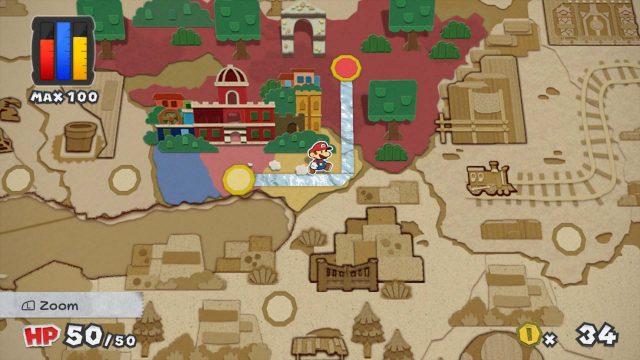
There’s also some elements to the gameplay package of Paper Mario: Color Splash that just feel needlessly strangely designed. Chief among these oddball design elements is the fact that only one save file is allowed per Wii U profile, in a disc-based game. This means that, unless you want to make a fake second profile on your Wii U, you’ll have to delete all of your progress if you want to start a new game. This is really unnecessary, and the fact that people are punished for wanting to re-live this adventure definitely doesn’t help its replay value. On another note, it’s also a bit weird that players are forced to use the Wii U Gamepad in a two-screen setup, despite Paper Mario: Color Splash also supporting off-TV play, and allowing you to play the whole game on the Wii U Gamepad Screen. Even factoring in needing the Wii U Gamepad Screen for the Dimensional Shift mechanic, it doesn’t feel like spreading combat in particular across two screens is truly necessary, nor is limiting players to only being able to use the Wii U Gamepad as their controller. When it comes down to it, Paper Mario: Color Splash trying to shoehorn in its small handful of Wii U gimmicks usually feels pretty forced, and will make some players wonder why the game wasn’t just designed in a more efficient, straightforward fashion.
Still, depending on how thorough you are with optional quests, primarily a Roshambo (read: Rock-Paper-Scissors) tournament distraction that serves as a chief way to amass more coins in the game, Paper Mario: Color Splash offers a decent-sized adventure that will last you about twenty hours in length. That’s not huge for an alleged RPG, but it’s still lengthier than the majority of Wii U games, even if there isn’t a whole lot of incentive to return to the game after you’ve completed the main story. There’s a few side distractions peppered throughout Prism Island, but none of them are nearly as compelling as the main plotline, giving players disappointingly little reason to keep digging into the experience beyond the main quest.
With its gameplay largely sticking to an established Paper Mario playbook beyond the couple of new ideas, the main draw of Paper Mario: Color Splash ends up being its storyline, which is actually surprisingly great. In contrast to the lesser-developed story of Paper Mario: Sticker Star especially, Paper Mario: Color Splash actually delivers one of this series’ better and more memorable storylines, even if it doesn’t ultimately dethrone the highlight plot of Paper Mario: The Thousand-Year Door.
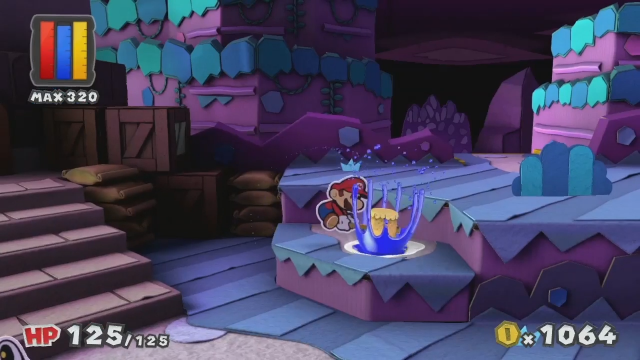
Still, the characters and storytelling are consistently clever, witty and at times even genuinely emotional in Paper Mario: Color Splash. For its occasional gameplay hiccups, it’s very easy to be taken in by the charm and personality of this game’s writing, which boasts a brilliant English localization rife with standout jokes that will have both younger and older players frequently chuckling and smiling. What begins as a simple quest by Mario and his new companion, sentient paint can, Huey to retrieve the lost Paint Stars of Prism Island, leads to all sorts of surprising stops that give the experience surprising depth and memorability, with Prism Island feeling like one of the most creative and lovable Mario RPG worlds designed to date!
Obviously, I would be remiss to spoil any element of this storyline, but I will say that if you appreciate funny and light-hearted gaming experiences, then Paper Mario: Color Splash is worth checking out. The storytelling is good enough to constantly keep you engaged in the otherwise straightforward adventuring objectives, which makes the pointless single save file limit sting all the more as well. This certainly isn’t the most impressive action-adventure/RPG offering on the Wii U alone, let alone competing platforms, but it’s at least a contender for being one of the console’s most emotionally satisfying and hilarious offerings in both genres.
Despite some of its design oddities and overall conservative gameplay foundation, Paper Mario: Color Splash is fun, filled with lovable personality, and feels like a worthy addition to the Paper Mario series, if also not an outstanding one. More hardcore RPG gamers are bound to gripe about the simplistic progression and controversial revival of the frequently-maligned Paper Mario: Sticker Star mechanics, but this direction nonetheless makes for a breezy Wii U adventure that, while not all that essential for non-fans of these games, is entertaining and made with plenty of heart.
Compared to a juggernaut like The Legend of Zelda: Breath of the Wild, Paper Mario: Color Splash still isn’t the most exciting swan song exclusive for the Wii U, but it’s a good example of the kind of heart that many of Nintendo’s Wii U exclusives often offered at their best, even as the console itself became an infamous retail flop. Granted, even the Wii U alone has deeper, meatier and more ambitious experiences than Paper Mario: Color Splash, let alone the competing PlayStation 4 and Xbox One consoles, or Nintendo’s own 3DS handheld, but if you do fall into this game’s clear-cut target audience of Paper Mario fans and/or comedic adventure enthusiasts, Paper Mario: Color Splash will give you a heartwarming final exclusive to enjoy on your Wii U, and maybe that’s enough for some.
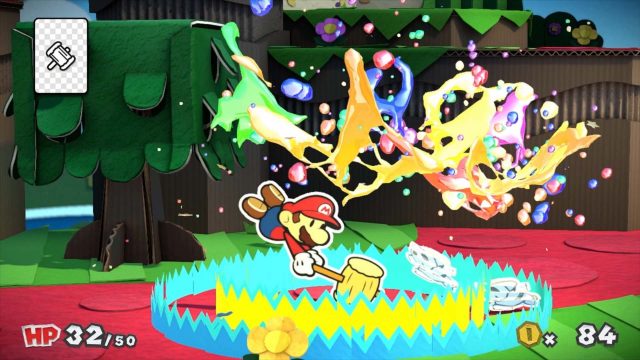
Thus, even if it’s not anything mind-blowing from a gameplay standpoint, don’t write off Paper Mario: Color Splash because of its similarity to the contested Paper Mario: Sticker Star. This is a deceptively lovable adventure that may not inject new life into the Paper Mario series, but does at least prove why these strange papercraft odysseys have continued to endure.
This review is based on a copy of, “Paper Mario: Color Splash” provided by Nintendo.

